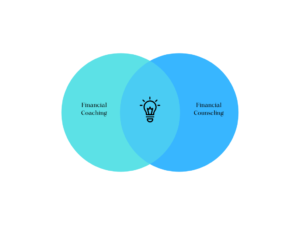Written By: Prince Bosompim and Catherine Komen
Introduction
While undoubtedly transformative, college life comes with its share of challenges, and among the most pressing is the financial burden students face. According to Hrynowski and Marken (2023), a recent survey reveals that 66% and 51% of college students report experiencing stress and worry, respectively, mainly due to their personal finances, as also found in a similar study of adults in the United States. In addition to the financial challenges posed by tuition fees, textbooks, and rising living expenses, college students grapple with unforeseen or unplanned expenses, including but not limited to job loss, accidents, car and home repairs, family emergencies, and medical crises. Research shows that this financial stress is a significant problem for college students, affecting their grades, chances of staying in school, and mental health (Britt et al., 2015; Lim et al., 2014).
Impact of Financial Distress on Mental Health and Academic Performance
Among the various contributing factors, financial stress has been associated with mental health issues, such as anxiety and depression (Tran et al., 2018). Even more alarming is its impact on academic performance, as it can lead to difficulty concentrating on academic tasks and lower grades. This may often be attributed to students needing to extend their work hours, leaving them with less study time. Consequently, students may find themselves dropping courses.
So, what can be done? One promising solution combines financial coaching and financial counseling to assist distressed students. While specific colleges have tried to support such students through financial coaching, the potential effectiveness of financial counseling in addressing students in financial crises remains largely underexplored.
Understanding the Differences Between Financial Coaching and Counseling
Financial coaching involves active listening, posing thought-provoking questions, mirroring client language, and reframing perspectives. Additionally, it includes facilitating client goal setting and attainment. Financial coaches focus on behavior and hold their clients accountable for adopting sound financial practices, providing guidance, support, and motivation to help them achieve their financial goals (Collins & O’Rourke, 2012). While coaching may touch on aspects of financial literacy education, its primary purpose is not to convey technical information.
In contrast, financial counseling utilizes similar techniques but aims explicitly to resolve financial crises, achieve financial goals, and enhance the client’s overall quality of life (Durband et al., 2018, pp. 5-13). Unlike coaches, financial counselors actively work to solve problems by brainstorming solutions. For instance, they may employ tools like an Excel spending plan or an online whiteboard to identify challenges, propose solutions, and prioritize the next steps with the student client. This approach helps participants visualize a positive and clear mental image of the desired outcome.
Synergy of Approaches
Despite the differences in client situation and objectives with each approach, recognizing the complementary nature of coaching and counseling underscores the importance of combining supportive strategies for college students facing financial challenges. The synergy between these approaches becomes apparent in their shared techniques, which contribute to a holistic support system. Furthermore, the practical guidance from coaching complements the emotional support and problem-solving skills from counseling, creating a complete approach to financial well-being. This comprehensive strategy not only equips students with the tools needed for effective financial management but also empowers them to address underlying issues, fostering sustainable financial health and resilience.
 Figure 1: A Synergy of Approaches
Figure 1: A Synergy of Approaches
Fresh Approach Creates Impact
At Texas Tech University, our Peer Financial Coaching Center, Red to Black, takes a comprehensive approach to assist students facing financial crises. The university offers temporary financial assistance to students experiencing difficulties continuing their education due to unpaid basic needs resulting from financial emergencies. When students are referred to our center, coaching sessions become “teachable moments,” utilizing insightful questioning to explore the core issues and generate practical solutions. Financial coaching plays a key role by guiding students to adopt positive financial behaviors, like creating and monitoring a spending plan, setting up an emergency fund, and maintaining a form of accountability, with a focus on enhancing financial literacy and promoting responsible financial practices.
Complementarily, our financial counseling approach employs problem-solving techniques to help students navigate immediate financial crises, manage stress, and enhance their overall quality of life. This approach addresses emotional and psychological factors contributing to financial challenges, fostering a deeper understanding of students’ relationships with money. This synergy not only facilitates immediate problem resolution but also creates opportunities for ongoing financial education, future coaching sessions, and the establishment of trust and connection within the student community.
Every Approach Brings Its Own Challenges
The mandatory nature of the referral process occasionally leads to student reluctance in embracing this approach entirely. Moreover, the approach requires a strong liaison with other campus partners along with both external and online resources for students.
In conclusion, by acknowledging the distinctive strengths of coaching and counseling, college financial wellness centers can harness their combined potential to address financial distress among college students, providing them with not only the tools and resources to manage their finances effectively but also the emotional and practical support needed to navigate complex financial situations.
About the Authors:
Prince Bosompim and Catherine Komen are both doctoral students in the School of Financial Planning at Texas Tech University. They also serve as members of Red to Black, a peer-to-peer financial coaching.
References
Britt, S. L., Canale, A., Fernatt, F., Stutz, K., & Tibbetts, R. (2015). Financial Stress and Financial Counseling: Helping College Students. Journal of Financial Counseling and Planning, 26(2), 172–186. https://doi.org/10.55504/0884-9153.1605
Collins, J. M., & O’Rourke, C. M. (2012). The application of coaching techniques to financial issues. Journal of Financial Therapy, 3(2), 3.
Durband, D. B., Law, R. H., & Mazzolini, A. K. (Eds.). (2018). Financial counseling. Springer.
Hrynowski, Z. & Marken, S. (2023) College students experience high levels of worry and stress, Gallup.com. Available at: https://www.gallup.com/education/509231/college-students-experience-high-levels-worry-stress.aspx (Accessed: 14 December 2023).
Lim, H., Heckman, S. J., Letkiewicz, J. C., & Montalto, C. P. (2014). Financial stress, self-efficacy, and financial help-seeking behavior of college students. Journal of Financial Counseling and Planning, 25(2), 148–160.https://ssrn.com/abstract=2537579
Tran, A. G. T. T., Mintert, J. S., Llamas, J. D., & Lam, C. K. (2018). At what costs? Student loan debt, debt stress, and racially/ethnically diverse college students’ perceived health. Cultural Diversity and Ethnic Minority Psychology, 24(4), 459–469. https://doi.org/10.1037/cdp0000207
 Want to get involved with AFCPE®?
Want to get involved with AFCPE®?
Here are a few places to start: Become a Member, Sign up for an Essentials Course, or Get AFC Certified today!
Want to be an AFC®, but don’t know where to start? Sign up for a free info session!